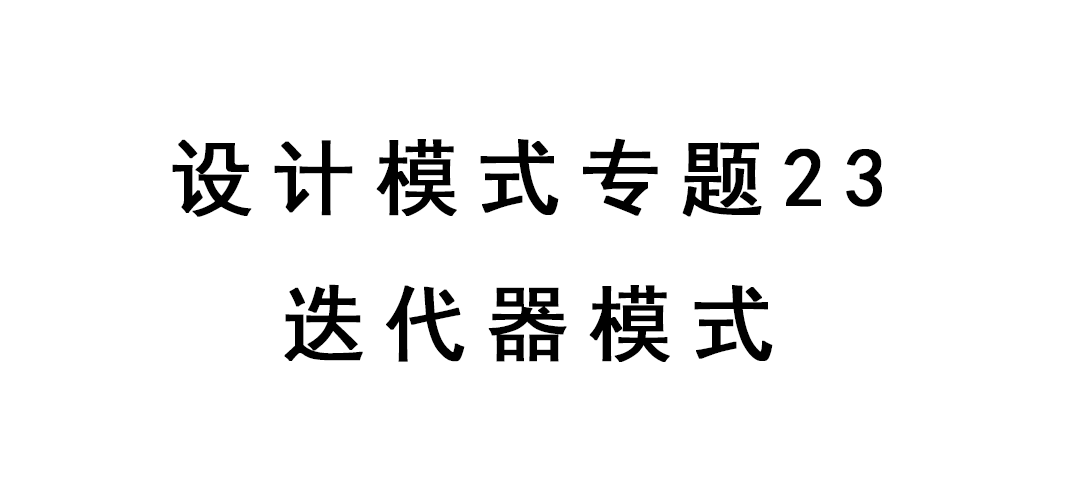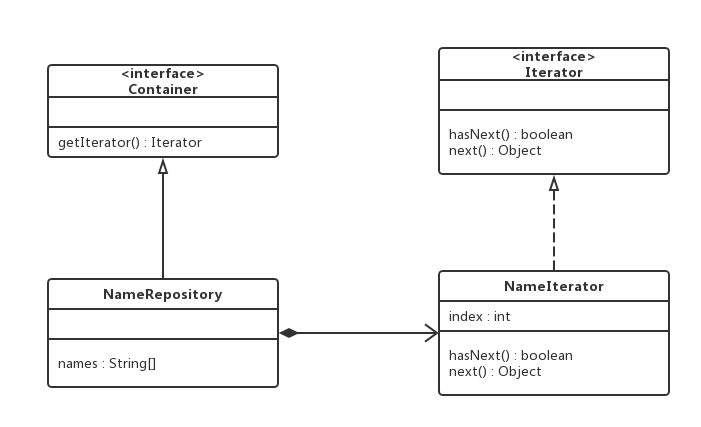
设计模式-23-迭代器模式
个人github地址:HibisciDai
设计模式系列项目源码:HibisciDai/DesignPattern-LearningNotes-HibisciDai
processon在线UML类图:processon
[TOC]
设计模式-23-迭代器模式
迭代器模式(Iterator Pattern)
意图
提供一种方法顺序访问一个聚合对象中各个元素, 而又无须暴露该对象的内部表示。
主要解决
不同的方式来遍历整个整合对象。
何时使用
遍历一个聚合对象。
关键代码
定义接口:hasNext, next。
如何解决
把在元素之间游走的责任交给迭代器,而不是聚合对象。
应用实例
JAVA 中的 iterator。
优点
- 它支持以不同的方式遍历一个聚合对象。
- 迭代器简化了聚合类。
- 在同一个聚合上可以有多个遍历。
- 在迭代器模式中,增加新的聚合类和迭代器类都很方便,无须修改原有代码。
缺点
由于迭代器模式将存储数据和遍历数据的职责分离,增加新的聚合类需要对应增加新的迭代器类,类的个数成对增加,这在一定程度上增加了系统的复杂性。
使用场景
- 访问一个聚合对象的内容而无须暴露它的内部表示。
- 需要为聚合对象提供多种遍历方式。
- 为遍历不同的聚合结构提供一个统一的接口。
注意事项
迭代器模式就是分离了集合对象的遍历行为,抽象出一个迭代器类来负责,这样既可以做到不暴露集合的内部结构,又可让外部代码透明地访问集合内部的数据。
案例1
模拟数组迭代
类图

代码
pattern23.iterator.demo1
1
2
3
4
5
6
7
8
9
10
11
12
13
14
15
16
17
18
19
20
21
22
23
24
25
26
27
28
29
30
31
32
33
34
35
36
37
38
39
| public interface Container {
public Iterator getIterator();
}
public interface Iterator {
public boolean hasNext();
public Object next();
}
public class NameRepository implements Container {
public String names[] = { "Robert", "John", "Jalie", "Lora" };
@Override
public Iterator getIterator() {
return new NameIterator();
}
private class NameIterator implements Iterator {
int index;
@Override
public boolean hasNext() {
if (index < names.length) {
return true;
}
return false;
}
@Override
public Object next() {
if (this.hasNext()) {
return names[index++];
}
return null;
}
}
}
|
测试输出
1
2
3
4
5
6
7
8
9
| public class Main {
public static void main(String[] args) {
NameRepository nr = new NameRepository();
for (Iterator it = nr.getIterator(); it.hasNext();) {
String name = (String) it.next();
System.out.println("name : " + name);
}
}
}
|
1
2
3
4
| name : Robert
name : John
name : Jalie
name : Lora
|


